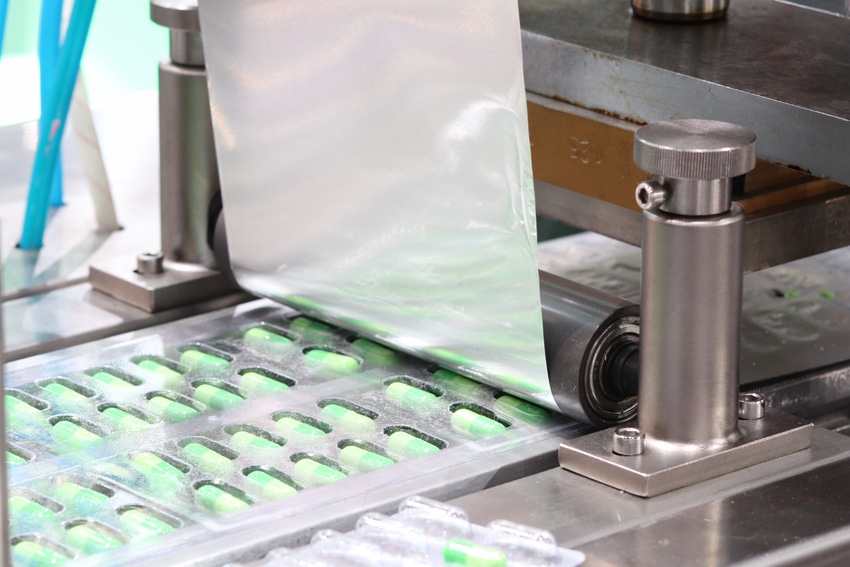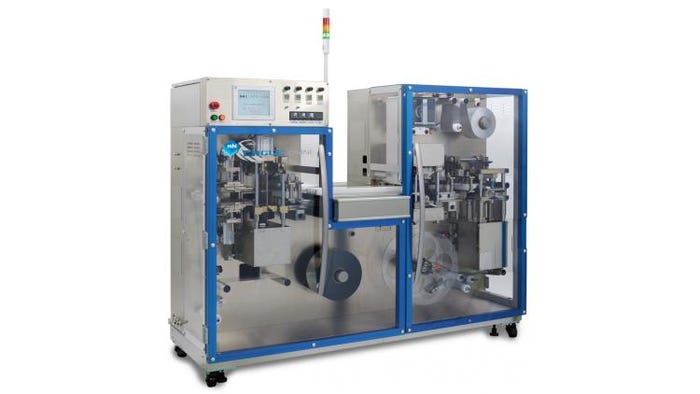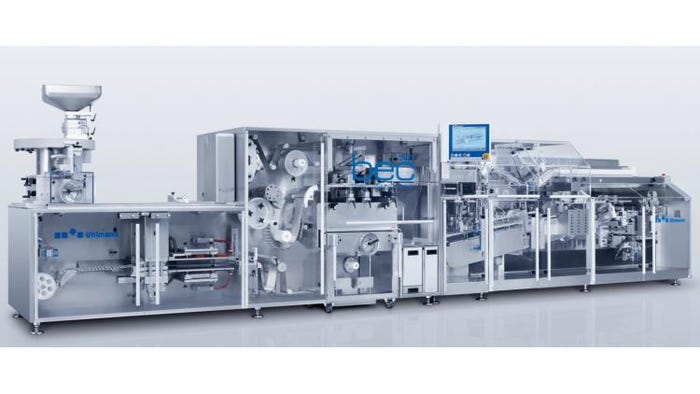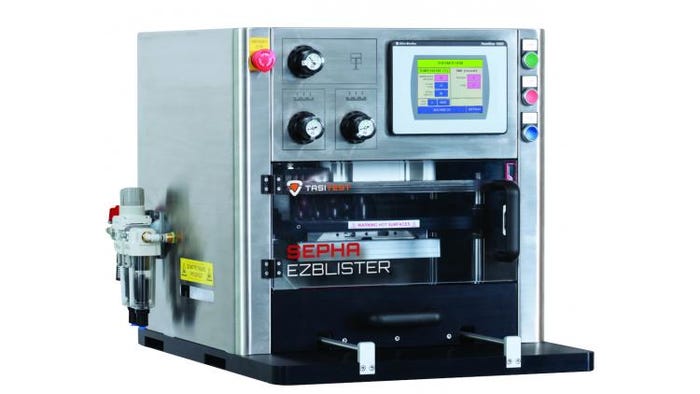
Pharmaceutical brand owners and the contract packagers that serve them are driving advancements in blister-packaging equipment that include faster changeover, compatibility with multiple blister formats and ease of operation.
Packaging Digest learned about these trends—and more—in a Q&A with experts from several leading blister-packaging equipment companies. The participants are:
• Tim Saarinen, chief operating officer for Maruho Hatsujyo Innovations (MHI);
• Brad Feldman, senior sales engineer at Thomas Packaging; and
• Michael Wagner, sales manager for Applications Support, Rebuilds and Aftermarket at Uhlmann Packaging.
What recent advancements have you seen in pharmaceutical blister-packaging machinery?
Saarinen: Prototype tooling for preliminary blister-card assessment of design, child-resistance, stability and market appeal is now available at a fraction of the traditional cost by utilizing 3D printing. Prototyping the blister cards allows design optimization prior to making the large investment in production tooling. Also, modern blister equipment is considerably more automated and easier to use.
Wagner: The clear tendency is toward even smaller batches. High-potency products and very expensive products are, more and more, what is packed in blisters. Therefore, the main goal is no rejects. “Easy to clean” is absolutely mandatory.
Feldman: As far as advancements,the feeders are better. There used to be just one kind of dedicated feeder, but now different companies are making feeders for various products. So you just get the change parts for tablets, capsules or whatever you’re filling, and it flows right into the cavity.
Is the emergence of more child-resistant carded blister packs having an impact on the development of blister-packaging equipment?
Feldman: Not the main blister machine, and that’s what we deal with. It’s all in the after-equipment—the card-sealer machines and the cartoners, things like that. The blister machine is just kicking out the blisters, and then the company does something with the formed blister, like putting it in a special machine for blister cards.
Saarinen: For products that have the volume to support integrated systems, more blister lines include integrated carding systems.
Wagner: Not necessarily. The machines are already capable of running child-resistant (CR) blisters. Peel-and-push, push-through or peel are doable on most of the machines.
How do the new advanced pharmaceutical blister-packaging systems compare to the existing standard equipment?
Saarinen: Modern blister equipment offers precise control of production parameters, which are typically PLC-driven with adjustment of values on the Human Machine Interface (HMI) for easier setup and adjustment. Setups are primarily recipe driven, and today’s machines are more capable of adjusting and compensating automatically to small changes in materials, print and other manufacturing variables. Format-part changeovers are faster and, frequently, tool-free.
Wagner: Smaller footprint and easier, faster changeover are musts. Smaller batches are requiring more changeovers and more blister-packaging formats.
Format pricing is therefore becoming more and more of a topic. This pricing speaks to how versatile you need the machine to be. The more formats (different types/shapes/sizes of blisters) you potentially need, the more versatile the equipment needs to be; that may entail purchasing optional add-ons with the machine.

The Eagle-Omni blister-packaging machine from Maruho Hatsujyo Innovations (MHI) can be used to fill solids, gummies, powders, liquids or devices. It is compatible with various feeding equipment and offers straightforward format changes.
What are the benefits of these advancements for packaging machinery buyers/users?
Wagner: Smaller machines are usually cheaper. The market is moving more towards basic (simpler/smaller) blister machines, which is a highly competitive market, and that is additionally impacting pricing.
Also, the users are becoming less and less trained, and the machines must be easier to use and to maintain.
Saarinen: Lower cost for prototyping and easier, more reliable operation with faster changeovers.
Feldman: The benefit of a dedicated feeder is that it’s more accurate, and it’s quicker. You’re getting a better fill rate, better speeds and better output.
What areas in pharmaceutical blister-packaging machinery still need work and why?
Saarinen: The need for faster, easy-to-use, reliable equipment that maximizes value will always continue. Simplified integration with auxiliary equipment such as feeder systems and cartoners, along with systems that have artificial intelligence built in to help in setup and reliable operation, are areas that continue to receive attention.
Feldman: I think liquid feeding still needs improvement, but is getting better.
Wagner: Expensive pharmaceutical products, particularly if they have a very high sensitivity to humidity. Also low-volume products.

The compact Blister Express Center 300, from Uhlmann, is an integrated system with blister and cartoner modules. Quick changeover makes the machine suitable for frequent blister-format changes.
Have aluminum tariffs spurred pharmaceutical companies to switch from all-aluminum blisters to plastic blisters with aluminum lidding?
Wagner: Alu-alu is used to create a really high moisture barrier, and it will still be used. Honeywell Aclar, with similar capabilities, is also very expensive, so no real change should be recognizable.
Saarinen: While the MHI machines are used to make blisters with plastic lidding and forming films, we have not seen a large shift away from aluminum in the market. While cost is always a factor, customers are selecting their forming and lidding materials primarily based on required functionality such as barrier properties, child-resistance and physical protection, along with marketing considerations such as shelf appeal. There are certainly new higher-barrier films available that compete with cold-form products.
What’s next with pharmaceutical blister-packaging machinery, and when might we see further improvements in this type of equipment?
Feldman: There are some advancements among materials suppliers. One of the vendors we work with is coming out with a new material designed for gummy hot-fill, where they fill a hot, gummy liquid into the blister; it cools and is nonstick. So the end user can just pop it right out of the blister. It’s very popular, especially in the cannabis market. That’s where a lot of our new business is at—the cannabis market.
Saarinen: Easier-to-use equipment with rapid changeovers is likely to continue to be a focus. Streamlined integration of accessories and peripherals will continue to be important. The use of artificial intelligence in the equipment to make the equipment easier to use, more robust to variations in the materials used, and to provide more efficiency will also be a focus.
Wagner: The next step might be single-dose serialization.

The Sepha EZ Blister, available from Thomas Packaging, is a tabletop blister machine that is suited to research and development, stability studies and small batches.
********************************************************************************
EastPack 2019 (June 11-13) is the region's premier packaging event connecting professionals from companies like PepsiCo, Pepperidge Farms and Mars with suppliers offering the latest packaging technologies, including a range of automation solutions, from semi-automatic equipment to sophisticated "smart" systems. Register to attend today!
About the Author(s)
You May Also Like




